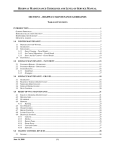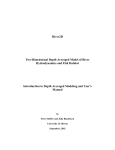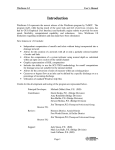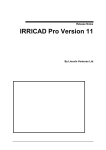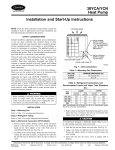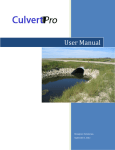Download AT Flow Profile Tool User Manual - Alberta Ministry of Transportation
Transcript
AT Flow Profile Tool User Manual Bridge Engineering and Water Management Section Technical Standards Branch April 2009 Table of Contents 1.0 Introduction................................................................................................................... 1 2.0 Input Data...................................................................................................................... 1 3.0 Output Data................................................................................................................... 3 4.0 Scenarios ....................................................................................................................... 4 4.1 Buried Culvert........................................................................................................... 4 4.2 Constrictive Bridge ................................................................................................... 5 4.3 Compound Culvert.................................................................................................... 5 4.4 Split Flow.................................................................................................................. 5 5.0 Hydraulic Calculations.................................................................................................. 6 5.1 Overview................................................................................................................... 6 5.2 Control Parameters.................................................................................................... 6 5.3 Subcritical Profile ..................................................................................................... 8 5.4 Supercritical Profile ................................................................................................ 10 5.5 Combine Profiles .................................................................................................... 12 ii 1.0 Introduction The AT Flow Profile tool performs one-dimensional (section averaged) steady flow hydraulics calculations for a crossing structure (bridge or culvert) on a prismatic channel (represented by one cross section). Calculations include a combination of rapidly varied flow (RVF), gradually varied flow (GVF), full (pressure) flow, and hydraulic jumps. Steep, mild and adverse slopes are all handled. Required input includes some basic geometric and roughness parameters for the channel and the crossing structure, a set of boundary conditions, and loss coefficients for expansions and contractions. Output includes a description of the flow profile for each section and values for depth and velocity at the ends of each section. A detailed table of the profile (depth, velocity, energy gradeline) along each section is also presented and plotted. Potential applications for this tool include : • • • • a constrictive trapezoidal bridge opening a buried culvert (including arch, ellipse, and round shapes) a compound culvert (multiple slopes, shapes) split flow (e.g. multiple culverts, flow over road) The tool applies basic hydraulic principles to provide the flow profile for constant flow conditions. The results should be an accurate reflection of the overall flow profile that will result from the scenario described in the input data. However, there will be sections of the profile where the actual profile may differ over small lengths, particularly at abrupt transitions were the flow is not fully developed. 2.0 Input Data As this tool analyses the impact of a crossing structure on a channel, data is required on the roughness and geometry of the structure and the channel. This data can be entered on the “Input” sheet, with a line of data entered for each section to be analysed. The data required for each section is as follows : • • • • • • Section Number – unique integer (1 to 10) for each section in ascending order Section Description – brief text string to be associated with a section U/S Elev – elevation of upstream invert of section D/S Elev – elevation of downstream invert of section Length – length of section along the stream profile Shape – shape of cross section for current section : o A – Arch shaped culvert (semi-circle on top of vertical walls) o B – Box shaped culvert (constant width) 1 • • • • • o E – Ellipse shaped culvert o R – Round culvert (span = rise) o T – Trapezoidal – used for channels and bridges Rise / h – culvert rise (invert to crown) or bank height ‘h’ (trapezoidal) Span / B – culvert span (widest width) or bed width ‘B’ (trapezoidal) T – Top Width (trapezoidal only) at bank height (width = T for Y > ‘h’) n – Manning roughness coefficient used as an override for default value (optional) Q – Flow for section (reduction from total flow entered as boundary condition) for use in split flow scenarios (optional) The slope of the section is shown on the input sheet adjacent to the section data, but it is a calculated value. Section data is required for each element to be analysed. The simplest scenario is a 3 section analysis for a constrictive bridge (channel – bridge – channel). A buried culvert would consist of at least 5 sections (channel – transition – culvert – transition – channel). A combination culvert would require additional sections. To simplify data entry for basic bridge and culvert cases, data can be entered on the “Template” sheet and the tool will generate the section data on the “Input” sheet. This data may still be revised prior to performing the hydraulic analysis. For both bridge and culvert options, channel data is required as follows: • • • • • B – bed width H – bank height T – top width S – slope of channel Elevation – reference elevation, applied to upstream invert of downstream channel. Additional data for a buried culvert is: • • • • • • Shape (A,B,E,R) Rise Span Length Burial – depth of invert below theoretical streambed, slope is assumed to be the same as the channel) Ltrans – length of transition channel between buried culvert and channel Additional data for a constrictive bridge is: • • B – effective bed width between headslopes (with adjustment for protection works) m – headslope slope ratio (H:V, e.g. 2 for 2:1) relative to the channel 2 • W – effective width of bridge section (length along the channel), equivalent to distance between transitions to and from the channel. Boundary condition data is entered on the “Input” sheet and consists of: • • Q – flow (cms) for steady flow analysis, applies to all sections which do not have a specified flow value (split flow scenario) and always applies to any channel sections. D/S BC Type – boundary condition type to be applied at the downstream end of the most downstream section. Types include : o N – normal flow is calculated for the downstream section and applied as the downstream boundary condition o C – critical flow depth is calculated for the downstream section and applied as the downstream boundary condition o # - a specified number will be taken as the depth to use as the downstream boundary condition. If the number is less than the critical depth, critical depth will be used. If the most upstream section is hydraulically steep, critical depth at the upstream end will be assumed as the upstream boundary condition. Additional data can be entered on the “Instructions” sheet. This includes expansion and contraction loss coefficients used in RVF calculations (default values are 0.3 for contractions and 0.5 for expansions). These coefficients are applied to the differential in velocity head between the upstream and downstream sections. Default roughness values (Manning ‘n’ coefficients) can also be entered for each shape of culvert or channel. If the roughness value is left blank for channel elements, the values specified in the AT Hydrotechnical Design Guidelines will be used. Roughness values can be overridden for any given section by specifying a value on the “Input” sheet. 3.0 Output Data Once the hydraulic analysis has been performed, the “Summary” sheet is displayed. A brief summary of the results for each section is displayed in a table. This data includes: • • • • • • • Section Number – unique integer identifier for the section Section description – text string entered previously for the section Yn – normal depth Yc – critical depth Profile – description of resulting profile using standard GVF nomenclature (M1,M2,M3,S1,S2,S3,A2) with combinations as necessary and with identification of full flow (Full) and hydraulic jumps (Jump). U/S Y – flow depth at u/s end of section U/S V – mean flow velocity at u/s end of section 3 • • • • U/S E – elevation of energy gradeline at u/s end of section D/S Y – flow depth at d/s end of section D/S V – mean flow velocity at d/s end of section D/S E – elevation of energy gradeline at d/s end of section In addition, a detailed table of profile results for each section is shown on the “Profile” sheet. Data shown is as follows: • • • • • • • • • Section Number – unique integer identifier for the section Station – cumulative distance from d/s end of analysis reach to current point X – distance from d/s end of current section to current point Y – calculated flow depth at current point V – calculated mean velocity at current point Invert – elevation of invert at current point Crown – elevation of crown at current point WL – elevation of water surface at current point EGL – elevation of energy gradeline at current point The “Plot” sheet presents this data graphically. In addition to channel inverts and culvert outlines, the water surface elevation and energy gradeline are plotted. Normal depth (if applicable) and critical depth are also shown. The plot will assist in the visualization of the impact of a proposed crossing in terms of increased depths (backwater, potential flooding impact) or decreased depths (higher velocities, risk of erosion). 4.0 Scenarios 4.1 Buried Culvert Analysis for a buried culvert consists of 5 sections (channel – transition – culvert – transition – channel). The easiest way to enter the data is to use the culvert template function, which will generate the necessary geometry data on the “Input” sheet based on the channel and culvert data entered on the Template sheet. Modifications to the generated data can be made prior to performing the hydraulic analysis. Boundary condition data will still be required on the “Input” sheet. The transition channels will have the same cross section as the main channel, but the invert will vary from the channel to the culvert, to account for the burial. For the upstream transition, this will result in a higher slope. For the downstream transition, this will result in an adverse slope. The impact on slope will depend on both the amount of burial and the specified length of transition. As these sections will often be lined with rock, an override value for roughness (e.g. 0.05) should be considered. 4 A wide range of hydraulic profiles can result at culverts, including full flow and hydraulic jumps. Potential upstream flooding, magnitude of increased velocities requiring protection works, and potential impacts on fish passage are all issues of interest. 4.2 Constrictive Bridge Analysis for a constrictive bridge consists of 3 sections (channel – bridge – channel). The easiest way to enter the data is to use the bridge template function, which will generate the necessary geometry data on the “Input” sheet based on the channel and bridge data entered on the Template sheet. Modifications to the generated data can be made prior to performing the hydraulic analysis. Boundary condition data will still be required on the “Input” sheet. A constrictive bridge will usually result in lower depths (higher velocities) through the constrictive opening, and higher flow depths in the upstream channel. The potential impact on upstream flooding can be readily assessed from the extent of the backwater curve in the upstream channel section. Although non-constrictive bridges openings can be analysed using this tool, there is generally little value in this use, other than confirmation that there is not a constriction. 4.3 Compound Culvert In some cases, especially replacement of culverts that have a large drop in elevation in the vicinity of the crossing (possibly due to degradation), the option of using a combination of culvert sections may be attractive. One such possibility is a 3 section culvert, which can make up the elevation drop while controlling velocities at the ends. Analysis of such a configuration may consist of 7 sections (channel – transition – low slope culvert – high slope culvert – low slope culvert – transition – channel). The goal is to contain the high velocities within the 3 culvert sections, with supercritical flow in the high-slope section a possibility. There are many possible configuration options, including lengths and slopes of the three culvert sections. Therefore, no template is provided for this scenario, and data must be entered directly into the “Input” sheet. 4.4 Split Flow A split in flow can occur at culvert crossings, such as at multiple culverts or with flow over the road. The specified discharge option allows for analysis of such situations. Entering a reduced discharge for a given culvert section will reduce the flow in the culvert versus the upstream and downstream channel. It is assumed that the rest of the flow is handled by other means, such as other pipes or flow over the road. 5 In the case of multiple pipes, analysis of each pipe will be required separately, and a trial and error process used to generate a combination of runs that results in the same water surface elevation in the upstream section for each pipe with the combined flow equaling the flow in the channel. In the case of multiple pipes of the same size and configuration, the specified flow can be set equal to the total flow divided by the number of pipes. In the case of flow over the road, the water surface elevation in the upstream section should match that used in separate broad-crested weir overflow calculations, with the combined flow equaling the total flow. 5.0 Hydraulic Calculations 5.1 Overview As a wide range of flow profile combinations can occur at stream crossings, a robust approach to the solution is required. The basic steps used by the “Flow Profile” tool are as follows: • • • • • • Read in Data – geometry, roughness, loss coefficients, and boundary conditions Calculate Control Parameters – critical and normal depth for each section Calculate Subcritical Profile – start at downstream end with boundary condition and work towards upstream, assuming no supercritical flow. GVF calculations are performed for each section, with RVF calculations between each section. Calculate Supercritical Profile – start at upstream section and work downstream, identifying any sections with potential for supercritical flow and calculate resulting profiles, including checking for transitions to subcritical flow (hydraulic jumps) Combine Profiles – interpolate between calculated subcritical and supercritical flow profiles for each section, developing the final profile at a regular spacing. Output Results – prepare table of summary values for each section, plus detailed table of profile through each section, and update plot. 5.2 Control Parameters In order to apply and combine GVF calculations values for critical (Yc) and normal (Yn) depth for the specified flow are required for each section. Yc is the depth at which the specific energy of flow at a section is a minimum. Flow depths greater than Yc are subcritical and flow depths less than Yc are supercritical. Yn is the depth at which the gravitational force on the flow is balanced with the friction force. Sections with Yn < Yc are considered hydraulically steep as opposed to hydraulically mild. Critical depth is determined by solving for Y using the equation: 6 Q 2T −1 = 0 gA3 Where: Q = flow (m3/s) T = surface width of flow (m) A = cross sectional area of flow (m2) g = acceleration due to gravity (9.806 m/s2) In the “Flow Profile” tool, most equations are solved using the double false position method. This method involves identifying an upper and lower bound to the solution, and then halving the difference multiple times while updating the limits until the solution is found. Although this approach is not as efficient as some other methods (e.g. Newton – Raphson which can zero in on the solution in a few iterations), it is quite robust in that it will always return a solution if one exists. In the case of critical depth, the tool uses an initial lower bound of Y = 0.0001. For culverts, the initial upper bound is set to the pipe rise. For open channels, an upper bound is iteratively searched for by incrementing Y until the value of the critical depth function changes sign. For all open channels, and all culverts with surface widths that approach zero as the depth approaches the pipe rise, a valid value for critical depth will be returned. In some cases, such as a Box pipe, a valid value for Yc may not exist and Yc is set equal to the pipe rise. Normal depth is determined by solving for Y using either the Manning equation or the AT open channel flow equation. The Manning equation is as follows: 2 Q− 1 A 3 2 R S = 0 n Where: R = hydraulic radius (A/P, m) P = wetted perimeter (m) S = slope of section The AT open channel flow equation (recommended for use in open channels with B > 10m, as per AT Hydrotechnical Design Guidelines), is as follows: 2 Q − 14 AR 3 S 0.4 = 0 In the case of normal depth, the tool uses an initial lower bound of Y = 0.0001. For culverts, the initial upper bound is set to the depth at which maximum open channel flow occurs (solved for separately in a similar fashion), as it is possible for two solutions to 7 exist for pipes with decreasing surface width as depth approaches the culvert rise. If this initial upper bound does not actually bound the solution, Yn is set equal to the pipe rise. For open channels, an upper bound is iteratively searched for by incrementing Y until the value of the normal depth function changes sign. 5.3 Subcritical Profile The calculation of the subcritical profile starts with the downstream boundary condition and works upstream through each section with a series of GVF and RVF calculations. The first (most downstream) section involves a GVF calculation starting with the boundary condition (either normal depth, critical depth, or specified depth). GVF calculations in the upstream direction are combined for steep and mild slope sections, but a separate routine is used for adverse slope sections. At the upstream end of each section, a RVF calculation is performed, with expansion or contraction losses accounted for. The RVF calculations generate the depth at the downstream end of the next section, which is then used in the GVF calculations for that section. A range of potential subcritical flow profiles can exist, as seen in the following table : Yds >Rise Section Slope All Other Profile Condition Type Sf > S Full >Rise Mild S < Sf M1-Full >Rise Steep S < Sf S1-Full >Yn Mild M1 >Yc Steep S1 =Yn (+/- 1%) =Yn (+/- 1%) Mild Mild <=Yc Steep Critical <Yn Mild M2 <Yn Mild <Rise Adverse <Rise Adverse Yn = Rise Yn = Rise Normal Full Full-M2 A1 Y>Rise Full-A1 Description Full flow throughout culvert, possible pressure flow Full flow at d/s end with M1 curve further upstream Full flow at d/s end with S1 curve further upstream Backwater curve, approaches Yn asymptotically from above Backwater curve, approaches Yc, may have finite length, may end at hydraulic jump Normal depth throughout section Full flow throughout culvert, possible pressure flow Theoretical profile, likely to be overridden by supercritical profile Drawdown curve, approaches Yn asymptotically from below Drawdown curve, approaches Yn asymptotically from below, may be full flow upstream Depth must increase in upstream direction, no Yn to approach Full flow upstream of an A1 curve if 8 Y > Rise along profile Where: Yds = the flow depth at the downstream end of the section Sf = friction slope (slope of energy grade line) Only Normal, M1, M2, A1, and S1 curves will apply to open channels. M1 and M2 profiles may be terminated if they are within a certain tolerance of Yn within the length of the section (tolerance set at 1%), with subsequent values set equal to Yn. If an S1 curve ends before the upstream end of the section is reached, upstream depth values are set equal to Yc. GVF calculations are performed by solving for Y2 in the equation: ⎞ ⎛ ( S f1 + S f 2 ) V2 V2 ⎜⎜ − S ⎟⎟ dx − (Y2 + 2 − Y1 − 1 ) = 0 2 2g 2g ⎠ ⎝ Where: V = section averaged velocity (m/s) In this equation, point 1 represents the current known point and point 2 represents the next point located a distance dx upstream. Sf is calculated using the Manning or AT open channel flow equation. This equation basically balances the friction loss over dx with the resulting energy gradeline change. The distance dx is specified by the tool (based on section length and the “Pts per Section” parameter entered on the “Options” sheet. The double false position method is used to find the value of Y2 that solves the equation. For mild and steep slope sections, the initial bounds to the solution for Y2 are set at Y1 (lower bound if drawdown curve, upper bound if backwater curve) and Yn. For adverse slopes, Y1 is set as the lower bound, and the upper bound is found by incrementally increasing the depth until the GVF function changes sign. If no solution is found (such as at the end of an S1 curve), Yc is returned for Y2. Once the subcritical profile for the entire length of the current section has been calculated, the values for Y,V, and energy gradeline are stored in an array for that section. In order to progress to the next section, a RVF calculation is performed between the upstream end of the current section and the downstream end of the next section upstream. This calculation accounts for losses due to contraction or expansion of flow that may result due to abrupt changes in invert elevation or cross section. The RVF equation solved for Y2 (point 2 being the upstream point and point 1 being the known downstream point) is: 9 EL2 + Y2 + V22 ⎛ (V 2 − V12 ) ⎞ ⎟⎟ = 0 − ⎜⎜ E1 + K 2 2g ⎝ 2g ⎠ Where: EL = Invert elevation E = value of the energy gradeline K = loss coefficient Again, this equation is solved using the double false position method, with the initial lower bounds set at Yc. For culverts, the upper bound is set at the culvert rise, with full flow resulting if no solution is found. For open channels, the upper bound is found by incrementally increasing Y until the sign of the RVF function changes. Until an answer is found, it is not known if the RVF is a contraction or an expansion. Since the coefficients usually differ (default contraction loss coefficient = 0.3, default expansion loss coefficient = 0.5), a contraction is initially assumed, and if the result proves to be an expansion of flow, the equation is solved again using the expansion loss coefficient. Once the RVF equation has been solved, GVF calculations can proceed in the next upstream section. Once all sections have been analysed, an array will have been populated with Y,V, and energy gradeline for the subcritical profile through all sections. 5.4 Supercritical Profile The next step is to develop a supercritical profile for the system, where applicable. In this case, the upstream section is examined first, with subsequent sections analysed while moving downstream. For the most upstream section, a supercritical profile is only calculated if the section is hydraulically steep (Yn < Yc). In this case, the assumed boundary condition is Yc at the upstream end of the section. GVF calculations then proceed in the downstream direction. If this section is not hydraulically steep, a flag is set to indicate that there is no supercritical flow for this section. Once the supercritical profile has been developed, a check is done for the occurrence of a hydraulic jump within the section. If a jump occurs, than the flag is set to indicate so. If no jump is found, then flow is supercritical when leaving this section, and the flag is set to denote this. For subsequent sections, the flag for the upstream section is checked to determine if the upstream section was flowing supercritical at the downstream end. If it was supercritical, then a RVF calculation is done to calculate Y at the upstream end of the next section, and GVF calculations undertaken for the current section. If the upstream section was not flowing supercritical at the downstream end (either subcritical or jump), then the section is checked to see if it is hydraulically steep. If so, Yc is applied at the upstream end and a GVF calculation undertaken. Otherwise, no supercritical flow is calculated for this section. For adverse slope sections, supercritical flow is not assessed even if the upstream section was supercritical at the downstream end (assumed jump at transition). 10 If supercritical flow does exist, a hydraulic jump is checked for, and the flag is set appropriately for this section. This process continues until the most downstream section is analysed. An array will then be populated with Y,V and energy gradeline for the supercritical profile for all sections. Y and V will be set to zero where supercritical flow is not a possibility. RVF calculations for the supercritical profile are similar to those of the subcritical profile except that Y1 is solved for (requires the RVF equation to be rearranged) and the bounds for the solution are modified, with Yc being the upper bound and Y=0.0001 being the lower bound. If a solution is not found, Y1 is set equal to Yc. The GVF calculations are not as complex as those of the subcritical profile, as full flow is not an issue and there are less profile types as possible solutions. Possible profiles are as follows: Yus <=Yc Section Slope Mild Other Profile Condition Type M3 <Yn Steep S3 >Yn Steep S2 Description Approaches Yc, may have finite length, may end at hydraulic jump Approaches Yn asymptotically from below Approaches Yn asymptotically from above The GVF calculations require the GVF equation to be slightly rearranged as the calculations proceed in the downstream direction. In addition, the initial upper and lower bounds are modified to reflect the different profile types. The additional aspect to the supercritical profile calculation is the checking for the possibility of a hydraulic jump. A hydraulic jump occurs at the transition from supercritical to subcritical flow and is calculated using the following force balance equation: ρgYCN A2 + ρQV2 = ρgYCN A1 + ρQV1 + ρgLS 2 1 ( A1 + A2 ) 2 Where: ρ = density of water (1000kg/m3) YCN = depth to centroid of flow area L = length of jump (assumed L = 6 (Y1 – Y2)) The terms with subscript no. 1 are for the subcritical flow and the terms with subscript no. 2 are for the supercritical flow. The terms with YCN account for the hydrostatic pressure force, the terms with Q account for the momentum of the flow, and the term 11 with L accounts for the down-slope component of the weight of the water in the jump. The increased hydrostatic pressure for full flow is accounted for, if present. This force balance equation is applied at 0.1m increments, starting from the upstream end until either a jump is found or the downstream end of the section is reached. Y1 and Y2 are determined for each position by interpolating within the subcritical and supercritical flow arrays, respectively. YCN is calculated by integrating over the cross section area of flow. If a jump is found, a flag is set and the location of the jump, plus Y1 and Y2 are stored for use in the routine that generates the composite profile for the section. 5.5 Combine Profiles Once the subcritical and supercritical profiles have been calculated, the final profile array is populated. If no supercritical profile has been found for a section, the subcritical profile is assigned as the final profile. If a supercritical profile has been calculated but no jump was found, then the supercritical profile is assigned as the final profile for that section. If a jump was found, a composite profile will be generated and assigned as the final profile for that section. The supercritical profile will be used upstream of the jump, the subcritical profile used downstream of the jump, and a straight line interpolation used for stations within the extent of the jump. If the theoretical length of the jump extends beyond the downstream end of the section, the jump will be truncated to end at the downstream end of the section. 12














